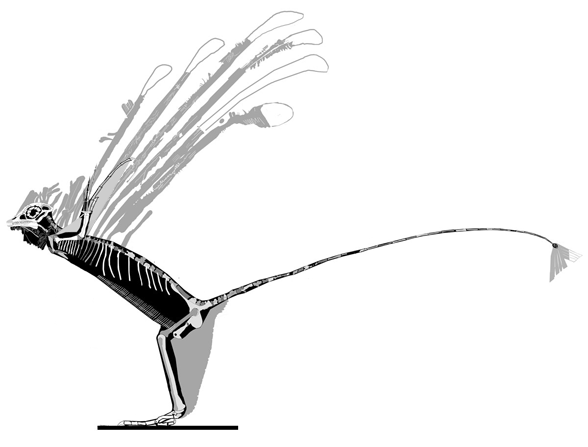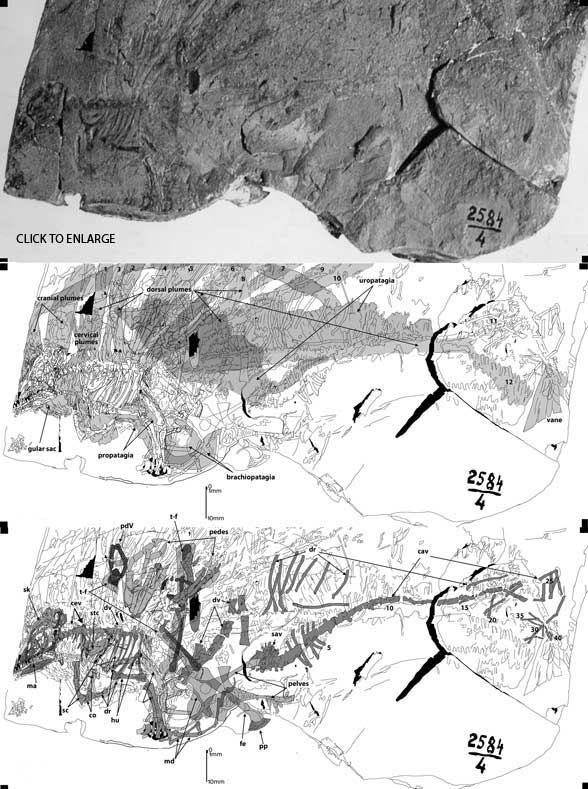Video here:
Response here:
As someone who has personally examined Longisquama (Fig 1), added it to three previously published phylogenetic analyses and had a manuscript peer-reviewed and published in Rivista Italiana (Peters 2000), I can tell you that Longisquama is more completely preserved than indicated in your video. It is a lepidosaur (like Huehuecuetzpalli) and a tiny tanystropheid (like Sharovipteryx, Cosesaurus and Langobardisaurus). It is also the current proximal outgroup taxon to the Pterosauria (like Bergamodactylus), but it was evolving in its own direction, as a plumed bipedal sprinter (proportions like Sharovipteryx). Think of Longisquama as a Triassic frillneck lizard (Chlamydosaurus). The plumes were not paired. There was no mandibular fenestra.
Longisquama had pycnofibers and a sternal complex (clavicles + interclavicle + single sternum, as in pterosaurs and just assembling itself in Cosesaurus). It also had a slender scapula and a stem-like, locked-down coracoid (as in pterosaurs, Sharovipteryx and Cosesaurus… and birds). This means it was flapping without flying. So it was a real active and flamboyant spectacle during mating rituals. Pre-pterosaurs emphasized their flapping wings during these rituals, so their wings grew larger. Longisquama emphasized its dorsal frills (also present in Cosesaurus), so its wings did not grow larger. Nevertheless, the fourth manual digit in Longisquama’s small hand was much longer than the other digits, and fibers trailed the forelimbs (as in Cosesaurus and pterosaurs). So Longisquama had small foldable ‘wings’, able to flap only (not fly) for mating rituals.
Longisquama had an antorbital fenestra (as in Cosesaurus, Sharovipteryx and pterosaurs) and the back teeth were multicusped (as in Bergamodactylus). One of the misinterpreted plumes, the one that goes off at an odd angle, is a leg. The feet are both present (twisted back atop the backbone at the base of the plumes) and a simple hinge ankle is present (as in Cosesaurus, Sharovipteryx and pterosaurs).
It is unfortunate that this information has been kept under wraps, despite peer review publication over twenty years ago. Part of the blame goes to professor Mike Benton who writes textbooks that continue the myth that pterosaurs are archosaurs close to dinosaurs. Remember: a long finger four, a long toe five, and an interclavicle are never found in archosaurs. In 1999 Benton promoted Scleromochlus as a pterosaur and dinosaur ancestor, so you could imagine how he felt when a year later a paper came out that said his conclusions were false due to taxon exclusion.
Google: “Cosesaurus aviceps, Sharovipteryx mirabilis and Longisquama insignis Reinterpreted” and “A Reexamination of four proclacertiforms with implications for pterosaur phylogenesis” for more information on Longisquama. Google: “Timeline of pterosaur origin studies” for more information on the suppression of Longisquama research when dealing with pterosaur origins.
References
Bennett SC 2008. Morphological evolution of the forelimb of pterosaurs: myology and function. Pp. 127–141 in E. Buffetaut & D.W.E. Hone (eds.), Flugsaurier: pterosaur papers in honour of Peter Wellnhofer. Zitteliana, B28.
Elgin RA, Hone DWE and Frey E 2011. The extent of the pterosaur flight membrane. Acta Palaeontologica Polonica doi: 10.4202/app.2009.0145 online pdf
Jones TD et al 2000. Nonavian Feathers in a Late Triassic Archosaur. Science 288 (5474): 2202–2205. doi:10.1126/science.288.5474.2202. PMID 10864867.
Martin LD 2004. A basal archosaurian origin for birds. Acta Zoologica Sinica 50(6): 978-990.
Peters D 2000. A Redescription of Four Prolacertiform Genera and Implications for Pterosaur Phylogenesis. Rivista Italiana di Paleontologia e Stratigrafia 106 (3): 293–336.
Peters D 2002. A New Model for the Evolution of the Pterosaur Wing – with a twist. Historical Biology 15: 277-301.
Peters D unpublished. Cosesaurus aviceps, Sharovipteryx mirabilis and Longisquama insignis Reinterpreted
Senter P 2003. Taxon Sampling Artifacts and the Phylogenetic Position of Aves. PhD dissertation. Northern Illinois University, DeKalb, IL, 1-279.
Senter P 2004. Phylogeny of Drepanosauridae (Reptilia: Diapsida) Journal of Systematic Palaeontology 2(3): 257-268.
Sharov AG 1970. A peculiar reptile from the lower Triassic of Fergana. Paleontologiceskij Zurnal (1): 127–130.
reptileevolution.com/longisquama.htm
wiki/Longisquama
researchgate.net/A_Reexamination_of_four_proclacertiforms_with_implications_for_pterosaur_phylogenesis
researchgate.net/Cosesaurus_aviceps_Sharovipteryx_mirabilis_and_Longisquama_insignis_Reinterpreted



Did you examine the fossil firsthand or did you asked someone to take good pictures and analyzed those pictures?
This is where fate stepped in. I live in St. Louis, USA. The Russian Dinosaur Exposition came through with Estemmenosuchus, Sharovipteryx, Longisquama and other fossils. Oddly the old and outdated website is still online: https://www.mathematical.com/dinoexpo.html
When I say ‘firsthand’ I mean firsthand. That was drilled into me early on by Bennett, Padian, Kellner and other workers I spent time with at symposia and at their homes and universities.
Obviously ReptileEvolution.com is not the same sort of study because quantity is needed to avoid the problem of taxon exclusion. That’s why some taxa are represented here by century-old engravings and online photos.
Ironically, it doesn’t matter whether or not one examines fossils firsthand as Benton and Hone’s supermatrix papers demonstrate. Building a supermatrix means you assemble several matrices, put them together and you need not look at fossils, photos or drawings to recover conclusions.
To your point, Bennett examined the flathead anurognathid (SMNS 81928) under a binocular microscope and ‘saw’ a single giant scleral ring instead of a flipped maxilla with teeth. Details here: http://reptileevolution.com/anurognathus-SMNS.htm
Firsthand examination also needs testing for confirmation, refutation or modification.
PS I also took good pictures (8×10 transparencies) for my files.
Well, at least you did examine the specimens firsthand. I had the idea that you asked a friend to take pictures for you to work with (perhaps I am mixing that up with how you examined Sharovipteryx?). Thanks for the context.
About the supermatrix thing, well, it depends. If you trust others’ character scorings you can indeed do it without firsthand examination. But if you think the other person’s scorings are wrong or you are missing characters you should ideally examine in person. The importance of firsthand examination is that you can see the fossil’s texture, different angles and analyze it with extra methods such as UV light, CT scans, etc. None of which you can do with pictures, but if other workers have already done that and scored their observations in a matrix you could indeed do it without having the fossil in your hands.
“Firsthand examination also needs testing for confirmation, refutation or modification.”
It has already happened more than twice and nobody has been able to replicate your observations of the posterior half or the “winglets” (my favorite examination so far is Buchwitz, M.; Voigt, S. (2012). “The dorsal appendages of the Triassic reptile Longisquama insignis: reconsideration of a controversial integument type”. Paläontologische Zeitschrift. 86 (3): 313–331. doi:10.1007/s12542-012-0135-3). That’s refutation. Moreover, your more extreme takes like the posterior half, the babies (I know you don’t stand by this anymore but it happened) and the exagerated plumes came AFTER the firsthand analysis. And also that you have changed your opinions multiple times after observing the same pictures (for example, in 2006 you said there was mandibular fossa. Right now you don’t think that. The same with the babies and the cranial plumes). It’s actually quite interesting how your first interpretation after firsthand examination was quite conservative. The weird stuff came after with DGS.
I would like to see a redescription of Longisquama with UV light and tomographies, but at the time it seems odd that every single person who was studied the fossil in person but you has not been able to see what you see.
Yes. I would also like to see Longisquama in other than visible light. When you say ‘every single person’, how many are we talking? Sounds like a big number. Reality is: much smaller.
re: “The dorsal appendages of the Triassic reptile…” here are my comments from 2012: https://pterosaurheresies.wordpress.com/2012/03/08/longisquamas-long-scales/
Re: The 2000 paper. That was my first attempt at a published paper and I did not choose an easy set of taxa for my debut. Mistakes were made. Observation of cryptic data is fraught with bias, freshman naiveté, peergroup pressure, textbook descriptions and other factors. It takes experience and a good Bauplan. That is why I revisited the data later (the ResearchGate revision). Think of it this way: When you learn to swim, you stay in shallow waters with grownups surrounding you. Only later do you gain the experience to go deep, where the interesting stuff is waiting to be discovered. This is reality. Appreciate that workers grow as they gain experience.
You wrote, “It has already happened more than twice and nobody has been able to replicate your observations of the posterior half or the “winglets”. Again, ‘nobody’ sounds like a big number. It is not a big number. Second: No workers (that is indeed a large number) have tested the tracing of the specimen I made to the same degree and detail. Let that happen first, then we can compare apples to apples.
Personal note: try to avoid attacking methods in general. The phrase ‘weird stuff came after DGS’ indicates nothing more than your distance from the materials under discussion. You’re acting like an umpire, not a player. In contrast to your point, many workers have adopted the method of coloring bones to understand them better in flattened specimens because it helps. Colors help readers understand the full extent of the data under review much better than pen and ink outlines with cryptic abbreviations. The final step of the scientific method includes describing data and results in public reports. I published in journals and now online in order to let other workers see and comment on the data in order to correct mistakes. There is no glory, money, or appreciation in this. But I do it anyway. So I appreciate your comments, but I wish you had examined the specimen and traced the elements and created a reconstruction so we could really talk in detail about Longisquama.
Penultimately, does it strike you improbable that my tracing of the roadkill specimen of Longisquama (click figure 2), which you consider random to questionable, somehow recovered an animal with Sharovipteryx-ish proportions and details? Somehow all four limbs were somehow symmetrical in every detail? Somehow the reconstructed skull has every element in common with Cosesaurus, Sharovipteryx and Bergamodactylus (with allowance for evolution)? The real issue is: prior workers glossed over Longisquama when it required greater attention to detail. Therefore, your beef should be with other workers for overlooking essential details recovered by others.
Finally, as I said before: let’s all play on an even playing field with other players. Let someone else (maybe you?) nest Longisquama with another taxon, then let’s compare competing trees. It is not an enigma without a solution. Let someone else produce a detailed tracing and reconstruction. Then let’s dive deep to compare the two or three competitive candidates and have a discussion about the evidence. Sound good?
Thank you for your comments and your interest in things I also find interesting. I hope we get to meet each other someday.